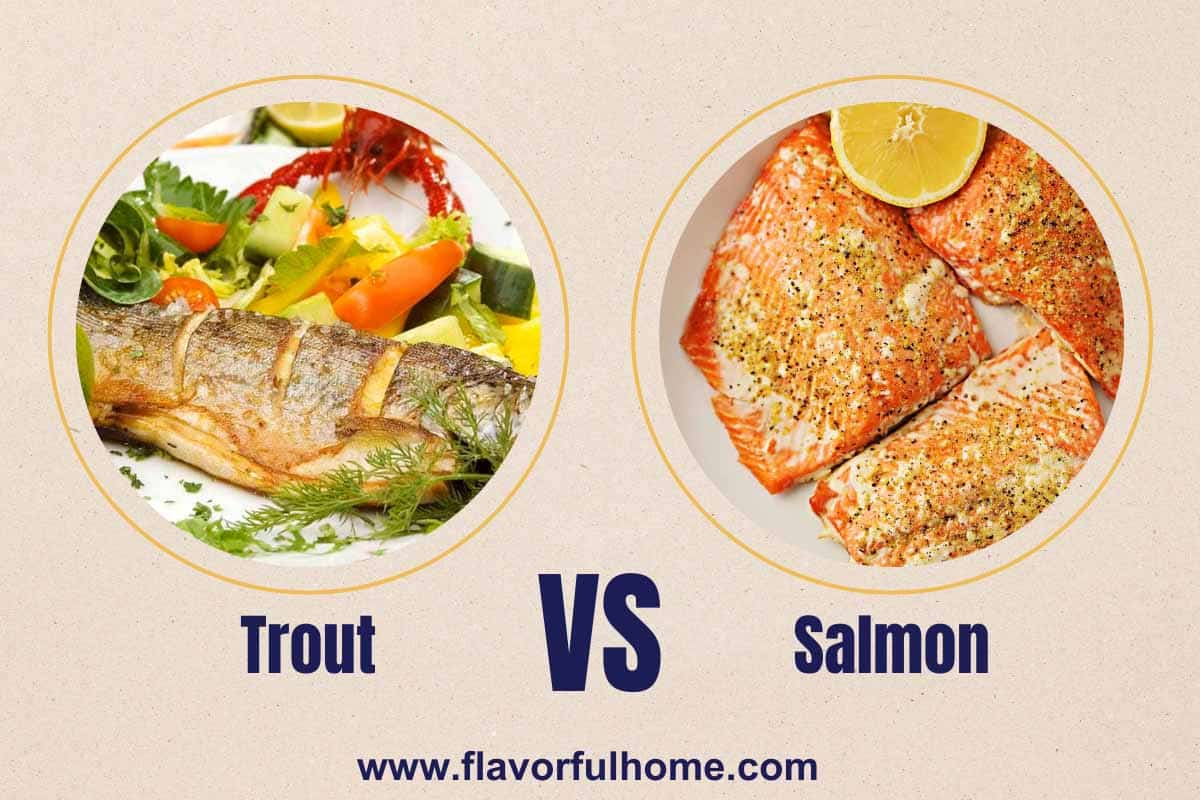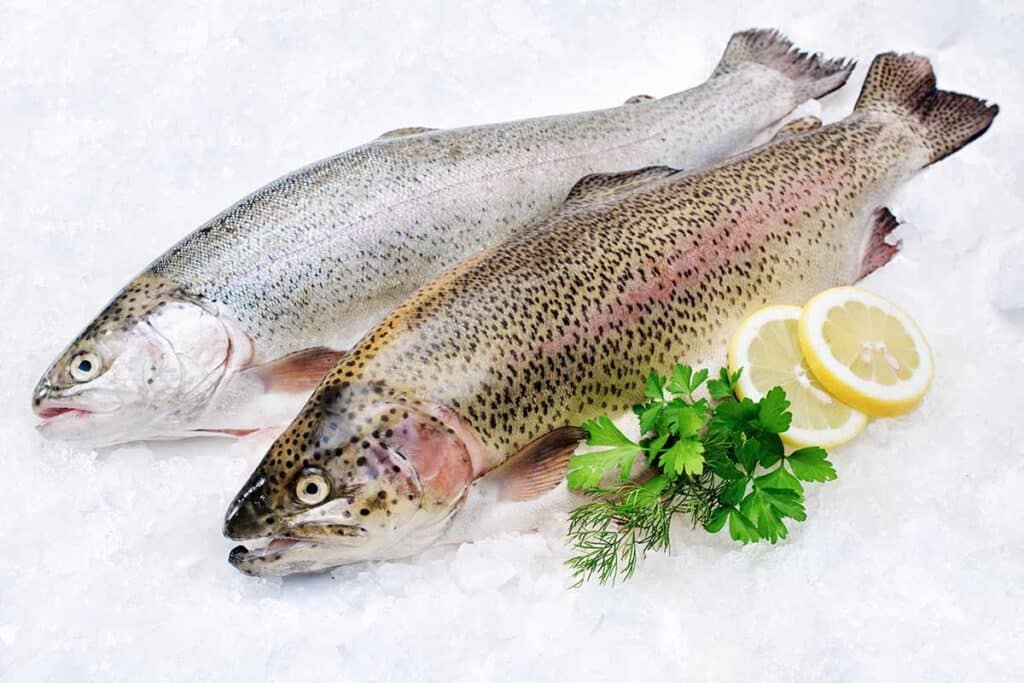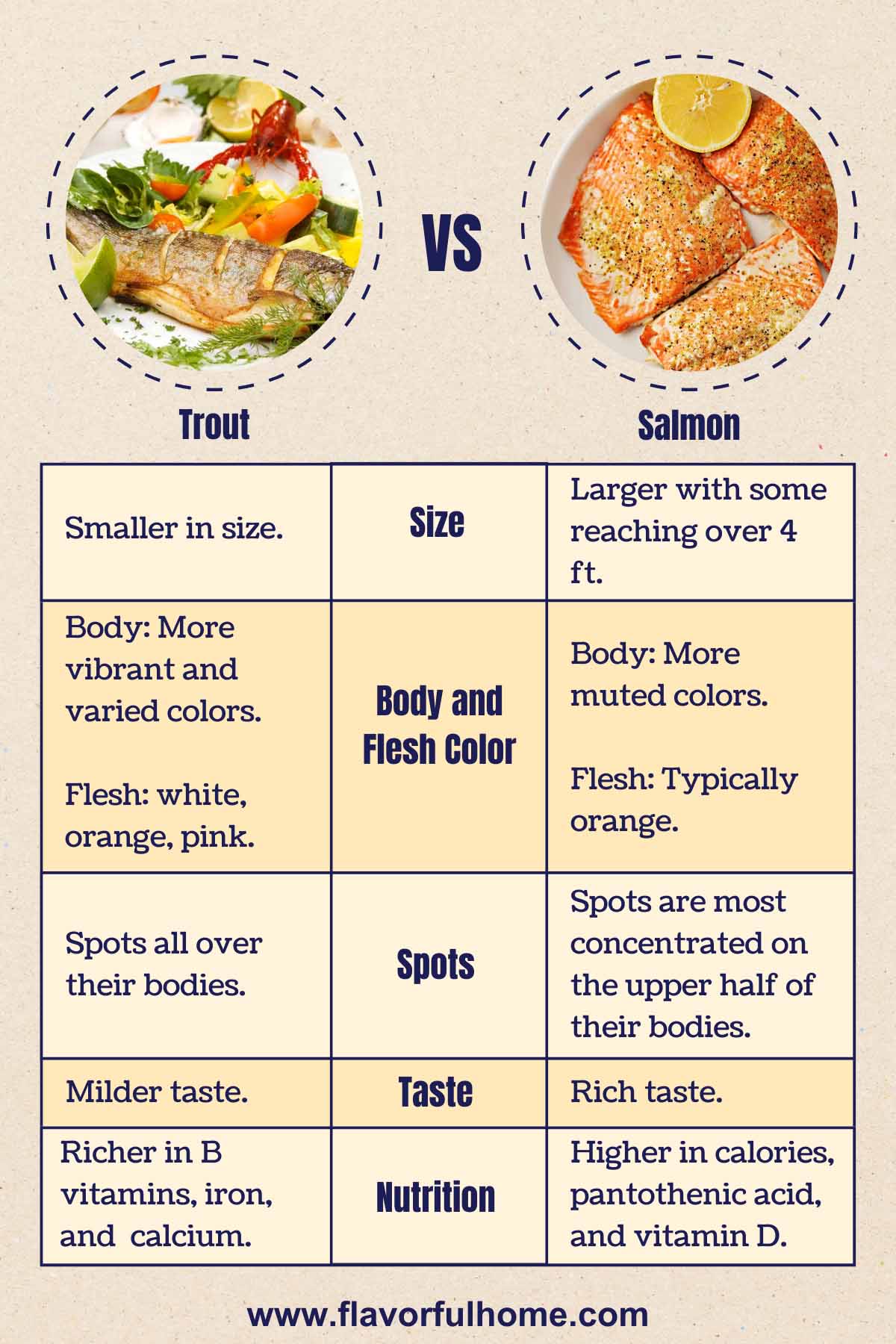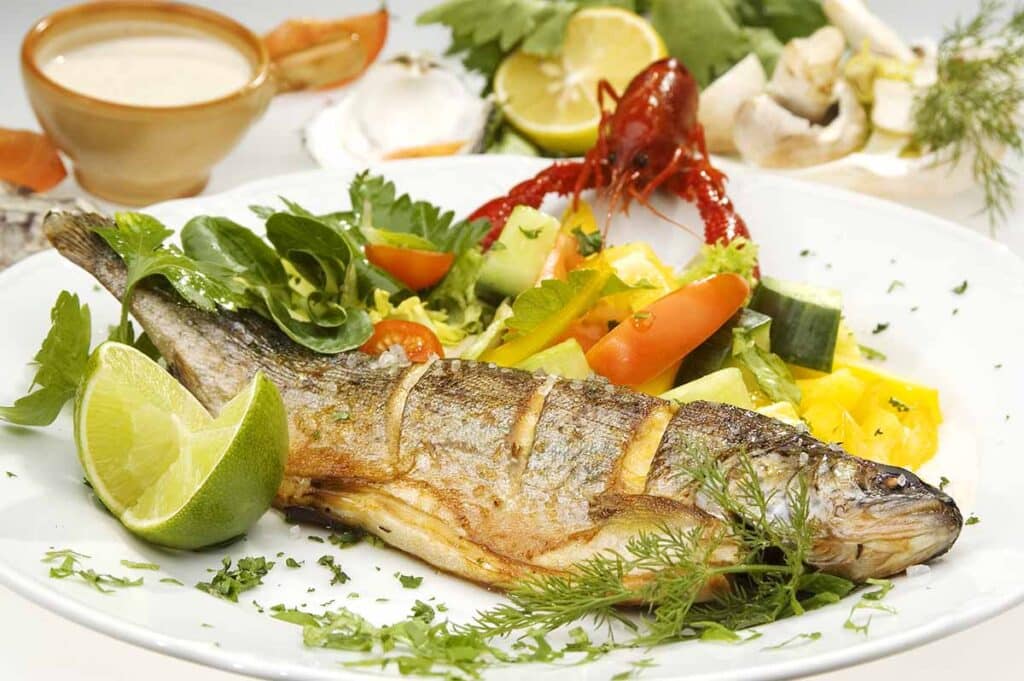For home cooks and professional chefs, selecting the right fish can make or break the recipe. In this article, we embark on a journey to explore the distinguishing traits of trout vs. salmon, from their flavors and textures to their culinary versatility.
When it comes to trout vs. salmon, the choice can be overwhelming. Understanding the difference in their characteristics and flavor profiles can help you decide which one to use.
In this article, we’ll compare trout and salmon in detail. We’ll also provide cooking tips to help you make the most of this delicious seafood.

Trout is known for its firm texture, mild flavor, and vibrant pink flesh. This gamey fish belongs to the Salmonidae family.
It is a versatile and flavorful choice for cooking enthusiasts.
You can mostly find this freshwater fish in northern Asia, Europe, and North America.
They inhabit cold rivers, streams, and lakes, making them a favorite angler catch.
Did you know?
Trout species vary in body structures, patterns, and colorations. The most common trout include the rainbow trout, Steelhead trout, brown trout (also known as speckled trout), brook trout and sea trout.
This fish preys on insects, small fishes, crustaceans, and their eggs. This kind of diet contributes to their taste.
Trout’s fat content differs among species, so it has varying levels of greasiness.
Despite being closely related to salmon, trout have a distinct flavor profile. You can enhance trout’s flavor depending on your chosen cooking method.
Grilling imparts a smoky touch to this gamey fish. Baking trout preserves its natural flavors, while pan-frying creates a crispy exterior.
Salmon is a prized saltwater fish in the culinary world.
The name salmon encompasses various species found in the Pacific and Atlantic Oceans.
Salmon has sleek bodies and captivating color transformations.
Did you know?
Most salmon species, including Atlantic salmon, Chinook salmon, Sockeye salmon, and Coho salmon, spend the majority of their lives in the ocean, migrating to freshwater rivers and streams to spawn.
Wild salmon is highly valued and is a significant food source. Salmon fishing is both a commercial and recreational activity for many people.
Still, due to conservation efforts, farmed salmon is the most common type in the market today. Purchasing them from sellers that responsibly source them is important.
When it comes to cooking, salmon offers a rich and flavorful experience. Its flesh has a distinct taste and delicate texture.
To showcase the natural flavors of salmon, you may grill, bake, or pan-sear it.
Also Read: What Does Salmon Taste Like?

We’ve got you covered if you’re curious about their appearance, flavor, or nutritional benefits.
Let’s look at the unique characteristics that set these two beloved fish apart.
Salmon are generally larger than trout.
Depending on the species, salmon can grow significantly larger, with some reaching lengths of over four feet and weighing several dozen pounds.
Trout, on the other hand, tend to be smaller, although sizes can still vary depending on the specific species.
At first glance, salmon and trout may look alike. They come from the same fish family, after all. Plus, due to their similarities, trout can pass as a salmon to the untrained eye. For this reason, some sellers usually take advantage of unknowing buyers and sell trout as salmon.
To distinguish trout from salmon, you can look at the tail first.
Salmon have concave tails, while trout have straighter, unforked tails.
Salmon and trout display distinct coloration patterns. While both species typically have silver-colored bodies, trout tend to have more vibrant and varied colors.
Rainbow trout, for example, exhibit a pinkish-red stripe running along their sides, accompanied by an array of spots that can range from black to red or blue.
In contrast, salmon often develop more muted colors, especially as they approach their spawning phase, with their bodies becoming darker and displaying red or maroon hues.
When it comes to the flesh color, salmon flesh is typically orange. There is a rare variety, the Ivory King salmon, that is unlike other salmon species. It has white meat.
The color of the trout’s flesh varies, too. They can be white, orange, or pink.
The spotting patterns on salmon and trout can also differ.
A salmon has fewer spots than a trout. Plus, the spots of the salmon are mainly concentrated on the upper half of their bodies. Trouts have more spots; you can find those all over their bodies.
Trout, mainly brown trout and brook trout, have characteristic spots on their sides and backs.
These spots are often surrounded by lighter halos or rings, creating a distinctive speckled appearance.

In summary, while you can source trout from various streams, rivers, and lakes, the sourcing of salmon is more specific to places with suitable habitats for their reproductive cycle.
You can source trout from a wide range of lakes, streams, and rivers across the globe. They are adaptable and can thrive in various freshwater environments.
On the other hand, salmon have a more specific sourcing pattern. They hatch in freshwater and then embark on their migratory journey to the ocean.
This unique life cycle sets salmon apart from trout. Sourcing salmon involves targeted fishing during their migration and spawning period.
When it comes to taste, trout, and salmon offer distinct flavor profiles.
Salmon has a lusciously fatty texture and rich taste that stands out. Its flavor is often described as more pronounced when people compare it to trout.
It is a popular choice for sushi and other similar dishes.
On the other hand, trout has a milder taste. The flavor of trout can vary based on its diet. So, it follows that different species will have different flavor profiles.
Rainbow trout, the most common variety, has a mild and nutty flavor close to salmon.
In most recipes, you can use both fish interchangeably.
Both trout and salmon offer valuable nutritional benefits, although their profiles differ slightly.
Compared to salmon, trout stands out for its richness in monounsaturated, heart-healthy fats.
Additionally, trout has higher levels of iron and phosphorus than salmon.
Salmon is particularly rich in polyunsaturated fats. It is specifically high in omega-3 fatty acids, which have their own health benefits. Salmon also offers more elevated amounts of copper, magnesium, and potassium.
When it comes to vitamins, trout has vitamins E, D, B1, B5, and B12. Salmon, on the other hand, has higher levels of vitamins B2, B3, and B6.
Both trout and salmon offer a diverse range of nutrients that can be a part of a balanced diet.
Eating salmon and trout allows you to enjoy their nutritional benefits.

You can prepare and cook trout and salmon similarly despite their slightly different characteristics.
Here are some of the best tips that can help you get the best culinary experience from salmon and trout:
To reduce the fishy aroma of salmon and trout, soak them in milk before cooking.
Doing so binds the compounds responsible for the fishy odor in the milk. So, when you discard the milk, you discard the fishy odors with it.
Aside from removing unwanted aroma, soaking the fish meat in milk also imparts a mild and pleasant milky taste that improves the overall flavor.
Removing excess moisture from trout and salmon by patting them with a kitchen towel or a paper towel.
Some people shy away from this because they think it will dry the seafood out.
What patting dry does, instead, is help you get even browning and a nice flaky texture.
It is best to use simple spices to let the fish’s natural flavor shine.
In most recipes, the good old salt and pepper combo is enough.
Butter, a dash of lemon juice, and a fresh herb like parsley are also top choices.
When frying or pan-searing trout and salmon, it is best only to turn them once. Especially if you want to make skin crispy and flavorful.
Turning the fish more than once might cause it to disintegrate.
Since trout and salmon are oily fish, pairing them with fresh and raw ingredients would be best.
You can cook it with fresh herbs, for example, like in this pesto salmon recipe. Or serve trout or salmon with a vegetable salad on the side.
You can also use fish as the protein in your green salad.
Cover trout and salmon fillets with flour before frying for an extra crispy bite.
Doing so gives your fish a nice texture on the outside.
Both salmon and trout are versatile fish that you can cook in various ways.
Depending on your preference, you can steam, grill, fry, or bake them.
For a different take to your pasta recipe, add chunks of deboned trout or salmon.
They will impart a slightly fishy but pleasant flavor to your classic dish.
Selecting the highest quality fish is crucial to ensure your dishes taste the best.
Here are things you need to remember when buying salmon and trout:
Fresh fish is always better, so buy yours from the local fish markets or seafood near you.
They can help you get the type of fish you need as they are knowledgeable about fish.
They can also do all the prep, including cutting it based on your preference.
If you prefer to avoid taking a trip to the wet market, you may also buy trout or salmon from reputable online retailers.
Since you won’t be able to examine the fish beforehand, read reviews on their website.
First, look for any signs of damage, like blemishes on fish skins.
Do not buy visibly damaged fish, as they’re likely to be of low quality on the inside, too.
If you’re buying fillets, watch out for any discoloration.
To further determine if the fish is fresh, lightly press your finger against its skin.
The fish should be able to snap back into shape within a few seconds. If not, the fish is not at its best quality anymore.
Then, do the smell test. Trout and salmon meat should smell like the sea and never have an overly fishy aroma.
The fish is most likely not fresh if it has a strong and off-putting aroma.
Frozen salmon or trout should be hard. Do not buy it if you can bend the flesh because that means the fish has started to thaw. Thawing can affect the quality of the fish.
If it has already begun to thaw when you’re still in the store, chances are it will be totally thawed before you even get home. It might be rotten before you can have the opportunity to cook or store them.
After buying the best quality fish, you must store it properly at home.
Wash the fish under running water to remove any debris or dirt. Then, wrap it in plastic bags or place them in airtight containers.
Store fish in the fridge within 2 hours of purchase. If you plan to keep them for more than two days, store them in the freezer instead.
For a more effortless thawing experience, place a sheet of wax paper between the fish before freezing. This way, you can take out just enough fish for your recipe without thawing the whole batch. Since you can keep them in a single container, you also save space in your freezer.
Stored in the freezer, salmon and trout can last for 2-3 months.
No. Trout and salmon are two different fish. They come from the same family, so there are similarities, particularly in their appearance. However, they differ in their habitat and diet, which means they also have different flavors.
As with any other food, the better one depends on personal preference. If you love milder flavors, trout would be the better fish. However, salmon is your best bet if you like seafood with a robust taste. Both fish have their unique qualities and nutritional benefits. If you haven’t tasted both, trying them to decide which you prefer most is best.
The price of seafood like trout and salmon varies. It depends on the variety, location, and availability of the fish. In general, salmon tends to be more expensive than trout. After all, it is more popular and has a higher demand. Still, prices can fluctuate. For this reason, it is always best to check with local markets or suppliers for the most accurate prices.
To tell trout from salmon, observe their tail shapes first. Salmon have concave tails, while trout have straighter, unforked tails. Their spot patterns also differ. Salmon have fewer spots concentrated on their upper bodies. Trout has more spots all over. Trouts also come with a lighter flesh color than salmon. Taste-wise, salmon has a richer, more pronounced flavor than trout, which has a milder taste.
Both salmon and trout have distinct flavors that appeal to different individuals. Here are some general characteristics of their taste profiles:
Salmon: Salmon has a rich and robust flavor with a hint of natural oiliness. Trout: Trout generally has a milder flavor compared to salmon. It is often described as delicate, slightly nutty, and with a clean, freshwater taste. The flesh is typically tender and has a subtle sweetness.
Do you find it challenging to tell trout vs. salmon? The key lies in observation. Trout are generally smaller than salmon and are primarily found in freshwater. Salmon are larger and spend most of their lives in the ocean before returning to freshwater to spawn.
When it comes to taste, trout tends to be milder and sweeter. However, salmon has a stronger, richer flavor. Trout vs. salmon is a common debate among fish lovers, but both fish are delicious and versatile. You can cook them in a variety of ways to suit different tastes.





